The Sapphire R9 280X Toxic Review
by Ryan Smith on October 10, 2013 8:00 AM EST- Posted in
- GPUs
- Radeon
- Sapphire
- Tahiti
- Radeon 200
Power, Temperature, & Noise
Having seen the gaming performance of the 280X Toxic, let’s move on to power, temperature, and noise to get a better look at the performance characteristics of Sapphire’s Tri-X cooler. This will also give us a chance to evaluate the costs of Sapphire’s significant factory overclock with respect to power consumption.
| Radeon 280X Series Voltages | ||||||
| Sapphire 280X Boost Voltage | Sapphire 280X Base Voltage | Asus 280X Boost Voltage | XFX 280X Boost Voltage | Ref 7970GE Boost Voltage | ||
| 1.263v | 1.2v | 1.2v | 1.2v | 1.218 | ||
At the base GPU clockspeed of 1110MHz Sapphire is able to stick to 1.2v for their GPU voltage, but to boost up to 1150MHz they have to go to 1.256v. This is high for a Tahiti chip, and although still in the safe zone for something with this large an air cooler it is reaching about as high as we like to take Tahiti while maintaining longevity.
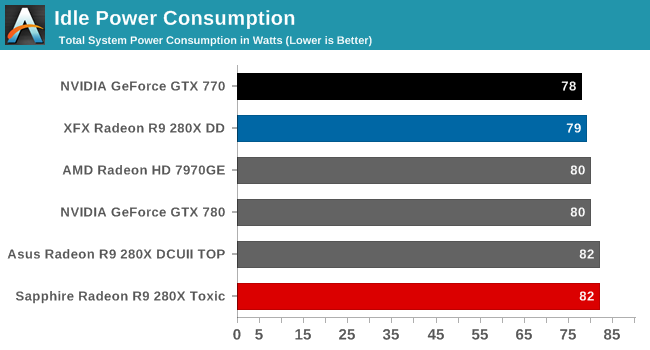
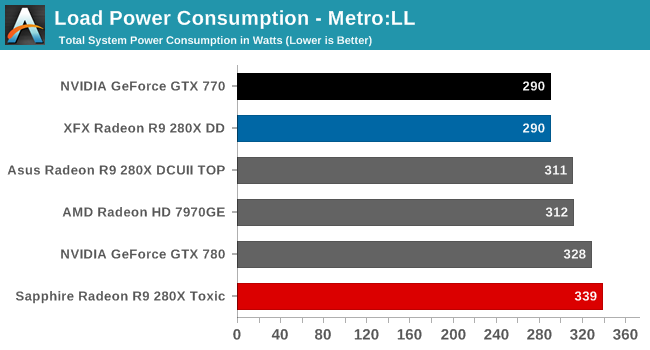
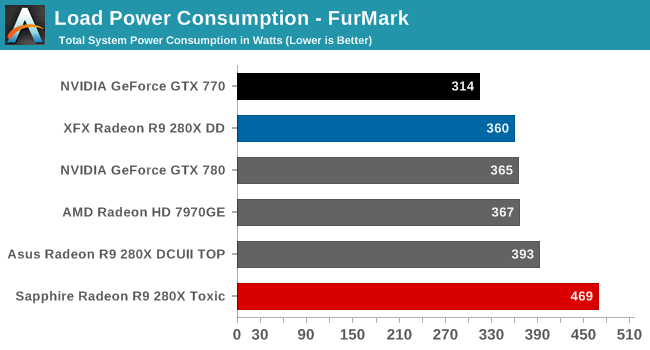
With the increased clockspeeds and voltages, rather expectedly we see an increase in power consumption. 339W (at the wall) under Metro is nearly 50W more than the stock 280X, and still 28W more than the overclocked (but not overvolted) Asus card. In fact it’s more than even the GTX 780, a card that still beats the 280X Toxic in our benchmarks.
FurMark shows a similar trend, with the 280X Toxic sustaining a load over 100W more than the stock 280X, or the GTX 780 for that matter. Sapphire has clearly set the PowerTune limit on their card higher in compensation for the amount of power a higher clocked, higher voltage GPU will take, and they have the cooling to back it up, letting the card draw this much power and sustain it. FurMark is a pathological case and gaming power consumption will be much closer to the Metro scenario, but it does show how high the Sapphire card can go under extreme load.
Consequently it’s clear that Sapphire has regressed some on the power curve to hit their performance targets. 1150MHz is unquestionably outside Tahiti’s sweet spot, so there is a significant power penalty to pay to get there.
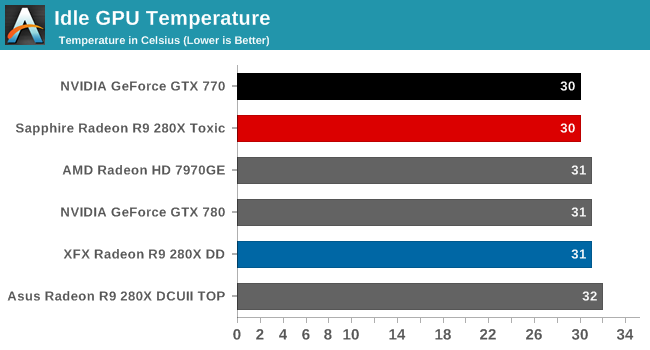
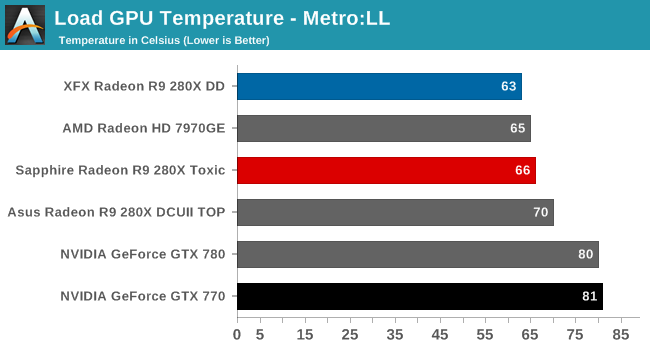

Considering the power numbers we just saw, Sapphire’s Tri-X cooler is earning its keep and then some. 66C under Metro is doing quite well for an open air cooled card drawing this much power, and the fact that FurMark temperatures only go to 75C despite the extreme power load there only further proves that the Tri-X cooler is up to the task for the Toxic. In spite of the high power draw, the card will have no trouble keeping up.
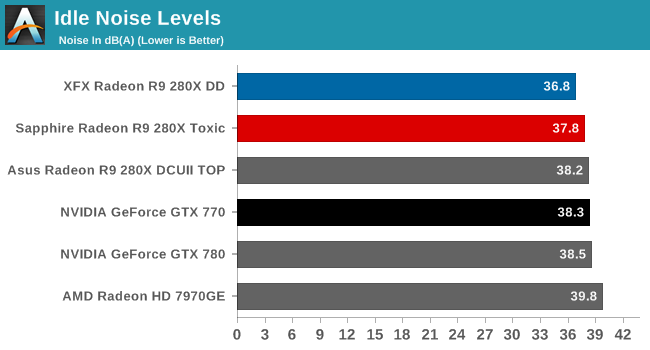
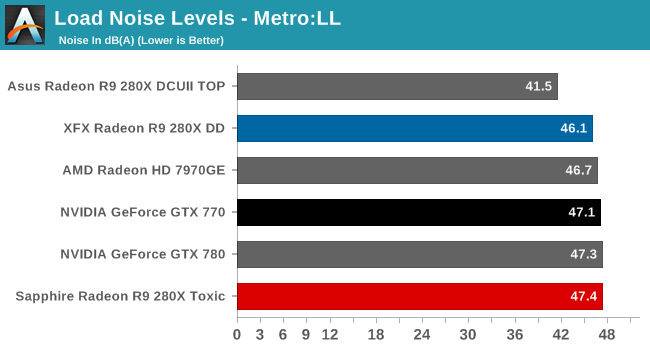
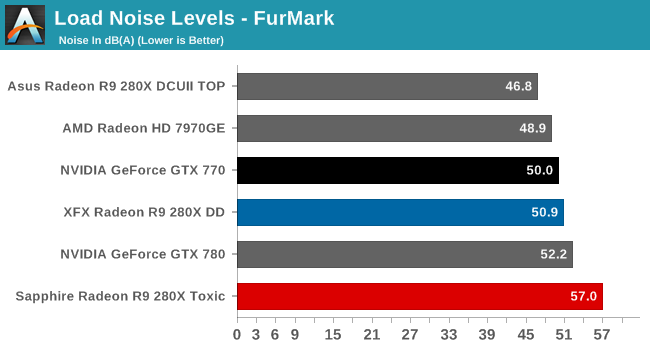
Finally our look at noise is something of a mixed bag for the 280X Toxic. The noise levels under Metro aren’t bad, but they’re also not great. At first glance Sapphire’s fan curve may be a bit aggressive, which is why we have 66C temperatures next to a 47dB(A) noise level. Next to the stock-clocked XFX card that’s a negligible increase in noise for a 13% performance increase, but the Asus card is something of a spoiler here. Asus in comparison gave up some cooling performance in exchange for lower noise levels and it shows. Sapphire could likely stand to be a bit less aggressive on cooling and bring those noise levels down, at least going by the conditions and results in our testbed.
FurMark on the other hand is outright loud, again going back to just how much power this card can draw when given a pathological use case and allowed to run free. I’m not sure if Sapphire could get away with a less aggressive fan curve here given the 75C temperature that goes with this noise level. Our testing methodologies don’t capture noise levels for other games, but based on our testing experience I don’t expect the card to get anywhere close to this under any game load, as those have always reflected what we see with Metro. Distributed computing/Bitcoin users likely wouldn’t be happy with this card though.
Ultimately Sapphire’s Tri-X cooler performs well under load here for typical workloads, and at least can easily keep up with the Toxic’s high power consumption under extreme workloads. The mixed results here ultimately come down to power consumption rather than the cooler itself.










84 Comments
View All Comments
truprecht - Thursday, October 10, 2013 - link
No, it's clear the Titan should cost less.nathanddrews - Thursday, October 10, 2013 - link
I meant more expensive than the 280X.ShieTar - Thursday, October 10, 2013 - link
Well, nobody who was looking for a good price-performance ratio was choosing the 780 over a 770 anyways, so the 280X really does not change anything here. Let's wait for the 290X and see what happens to the pricing of the 780 and the Titan then.Impulses - Thursday, October 10, 2013 - link
NV said they had no plans to drop the 770's price, I would think a 780 drop is even less probable unless 290X just trounces it... Heck the 280X mostly matches or outperforms the 770 and it's $100 less!I'd been thinking of going NV for my next upgrade (from 2x 6950s), but if AMD can come thru with their frame pacing driver update for Eyefinity in November I'll probably choose AMD again.
EF seems more flexible than Surround anyway, software-config wise.
HisDivineOrder - Thursday, October 10, 2013 - link
nVidia won't admit they're going to do a price drop until they are DOING a price drop. Saying, "Yeah, we're gonna do one. In a few weeks. You know. Once we sell as many GPU's before we have to drop," seems like it'd be stupid to say.just4U - Saturday, October 12, 2013 - link
I really don't know what to make of any of this.. when Nvidia's high end 6x series came out it widely accepted as beating out the 7950-70 yet somehow or another Amd caught up. Than along comes Nvidia's high end 7x series and the 7970GHZ manages to kinda sort of keep pace. Than we have these new cards which are based loosely on the those cards and at stock their coming very close to... I think Anand said within 5% or so. That tells me that there isn't really a huge difference so it will be interesting to see what comes out of amd with their top end cards.It's clear there's no night/day difference so far.. anyone with a good card in the last year and a bit is sort of set for now.
adamantinepiggy - Thursday, October 10, 2013 - link
The article lists this as having "two" dual-link DVI ports. As far as I'm aware, none of the current ATI model video cards have "two" dual-link DVI ports, and issue I ran into when I wanted to drive two big cheap Korean Shimian 2560x1440 monitors that only come with dual link DVI inputs.adamantinepiggy - Thursday, October 10, 2013 - link
Oops, meant AMD video cards, but still think have ATI brand embedded in brain.Ryan Smith - Thursday, October 10, 2013 - link
It's a bit confusing. They're always physically DL-DVI ports; but electrically you're right, they can only drive 1 DL-DVI monitor. I'll go amend that to try to clarify it.commissar0617 - Saturday, October 12, 2013 - link
newegg says 2x dual-link. adamantine is wrong.